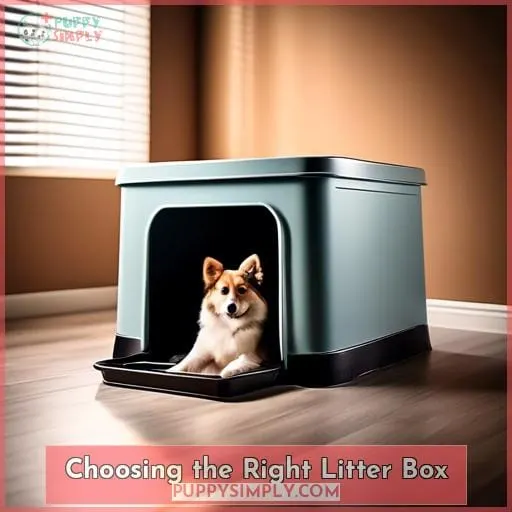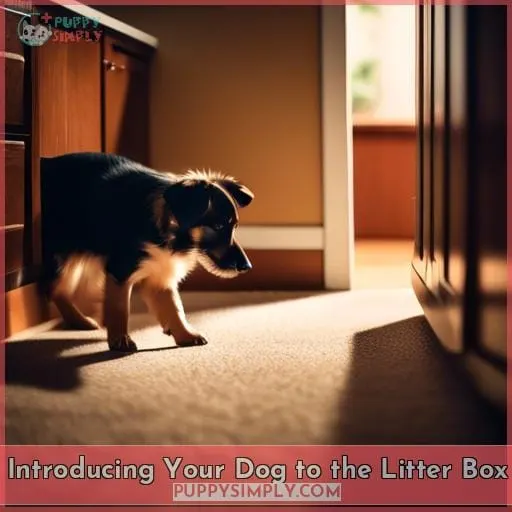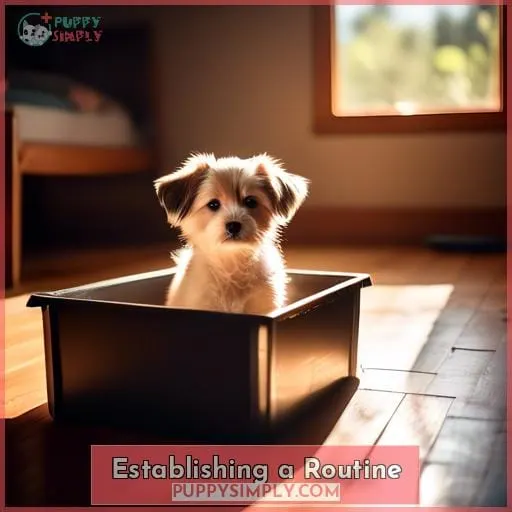This site is supported by our readers. We may earn a commission, at no cost to you, if you purchase through links.
 Just like cats, dogs can be trained to use a litter box. It’s a great option if you live in a place where taking your dog outside to use the bathroom is difficult.
Just like cats, dogs can be trained to use a litter box. It’s a great option if you live in a place where taking your dog outside to use the bathroom is difficult.
Litter box training your dog is a great way to give them a convenient and safe place to go potty.
With the right approach and a little patience, you can train your dog to use a litter box in no time.
Table Of Contents
- Key Takeaways
- Litter Box Training Basics
- Choosing the Right Litter Box
- Preparing the Litter Box
- Introducing Your Dog to the Litter Box
- Establishing a Routine
- Troubleshooting Accidents
- Maintenance and Care
- Frequently Asked Questions (FAQs)
- What are some common reasons why dogs might have difficulty learning to use a litter box?
- How can I prevent my dog from tracking litter outside of the litter box?
- What are some tips for making the litter box more appealing to my dog?
- How often should I clean the litter box, and what is the best way to do it?
- Is it possible to train a dog to use a litter box if they have already been trained to go outside?
- Conclusion
Key Takeaways
- Establish a consistent routine for bathroom breaks and take the cat to the litter box frequently.
- Use positive reinforcement such as treats and praise when the cat uses the litter box correctly.
- Clean up accidents with an enzymatic cleaner and avoid punishment as it can lead to further accidents.
- Scoop out waste daily, empty and clean the box entirely at least once a month, and use scented litter or baking soda to control odors.
Litter Box Training Basics
Once you’ve chosen the right litter box and location, you can start getting your dog used to using it.
Litter box training is a gradual process that requires patience, positive reinforcement, and consistency.
It’s essential to understand your dog’s behavioral patterns and environmental factors that may influence their potty habits.
Start by introducing your dog to the litter box gradually.
Place it in a quiet, easily accessible area and encourage your dog to explore it by placing treats inside.
Once your dog is comfortable with the box, start giving verbal cues like go potty or use the box whenever you take them to it.
Consistency is key to successful litter box training.
Take your dog to the box at regular intervals, especially after meals, naps, and playtime.
This will help establish a routine and make it easier for your dog to associate the box with elimination.
Choosing the Right Litter Box
When choosing a litter box for your dog, you’ll want to consider:
- The size of your dog
- The type of litter you’ll be using
- The location of the box in your home
You’ll also want to make sure the box is easy for your dog to get in and out of.
Choosing Litter Box
When choosing a litter box:
- Select one that’s large enough for your dog to comfortably use and has low sides for easy access.
- Consider materials like plastic or stainless steel for easy cleaning and odor control.
- Opt for a box with a lid or enclosed design to minimize odor and provide privacy.
Ensure the box is placed in:
- A quiet, easily accessible area to encourage regular use.
Training Techniques
To begin your dog’s litter box training, select one large enough for your dog to comfortably stand and turn around in.
Place the box in a private, easily accessible area, away from their food and water bowls.
For odor control, sprinkle baking soda on the bottom of the box and scoop out waste daily.
Replace the litter entirely once a week to keep it fresh and inviting.
Maintaining Cleanliness
With the litter box chosen, you’ll need to maintain cleanliness:
- Scoop out waste daily.
- Empty the box weekly.
- Wash it monthly.
Use an enzyme cleaner to remove odors and stains.
Keep the area around the litter box clean by sweeping or vacuuming regularly.
You can also use grass pads or dog litter to help absorb urine and control odors.
By maintaining a clean and sanitary litter box, you’ll encourage your dog to use it and prevent accidents.
Preparing the Litter Box
Next, prepare the litter box by filling it with the chosen litter material.
Select a litter that’s specifically designed for dogs, as cat litter can be harmful if ingested.
Clay or activated charcoal litter are popular choices, as they’re absorbent and help control odor.
Fill the box to a depth of 2-3 inches, as this will allow your dog to dig and bury their waste.
Place the litter box in a location that’s easily accessible for your dog, but also private.
Avoid high-traffic areas or places where your dog may feel disturbed.
You may want to experiment with different locations to find one that your dog prefers.
If you have a small dog, you may need to use a low-sided box or a plastic container to make it easier for them to get in and out.
Introducing Your Dog to the Litter Box
After preparing the litter box, gently guide your dog into it.
Let your dog sniff around and explore the litter box in a familiar environment.
Don’t force your dog to stay in the box if it’s hesitant.
Instead, encourage exploration by using positive reinforcement.
Create a Positive Experience:
Make the litter box experience enjoyable for your dog by rewarding them with treats, praise, or petting when they use it correctly.
This positive reinforcement will encourage your dog to associate the litter box with a pleasant experience.
Establish a Consistent Routine:
Take your dog to the litter box at regular intervals, such as first thing in the morning, after meals, and before bedtime.
Consistency will help your dog learn when to use the litter box.
Provide Guidance and Supervision:
When you first introduce your dog to the litter box, stay with them and provide guidance.
If your dog starts to eliminate outside the box, gently redirect them back to the litter box.
Be Patient and Reward Progress:
Litter training takes time and patience.
Don’t get discouraged if your dog doesn’t use the litter box right away.
Be patient and continue to reward progress.
Establishing a Routine
Once your dog understands the command, create a routine by taking it to the litter box:
- First thing in the morning
- Before bed
- Before it’s confined or left alone
This timing consistency will help your dog anticipate and remember when to use the litter box.
Pay attention to your dog’s behavioral cues. When you notice signs that your dog needs to go, like sniffing around or circling, immediately guide it to the litter box. This positive reinforcement will teach your dog that using the litter box is a rewarding experience.
Establish a daily schedule for your dog’s bathroom breaks. Take it to the litter box at regular intervals, such as:
- After meals
- After naps
- After playtime
This routine will help your dog develop a regular elimination schedule and reduce the likelihood of accidents.
By following these steps and maintaining a patient and consistent approach, you can successfully train your dog to use a litter box, providing convenience and stress-free living for both you and your furry friend.
Troubleshooting Accidents
Accidents are bound to happen during litter box training.
Don’t punish your furry friend; it’ll only make matters worse.
Instead, clean up the mess right away with an enzymatic cleaner to eliminate the odor.
Confinement to a small, litter box-equipped space might be necessary if accidents persist.
Positive reinforcement is key.
When your dog uses the litter box correctly, shower them with praise and treats.
This reinforces the desired behavior and makes them more likely to repeat it.
Environmental cues and consistency are crucial.
Take note of your dog’s potty schedule and environmental cues, like circling or sniffing, that indicate their need to go.
Respond promptly by guiding them to the litter box.
Consistency in training and routine will help your dog learn faster.
Maintenance and Care
While accidents will happen initially, you can ensure a clean litter box routine.
Scoop out waste after each use.
Empty and clean the box entirely at least once a month.
This prevents odors and keeps the area sanitary for your dog.
Using a scented litter or sprinkling baking soda at the bottom of the box can help control odors.
Avoid scaring or rubbing your dog’s face in the waste if they’ve had an accident.
This can create negative associations and deter them from using the litter box.
Instead, use a sharp clap to startle your dog if they start to eliminate outside the box.
Quickly take them to the litter box to encourage them to finish there.
Frequently Asked Questions (FAQs)
What are some common reasons why dogs might have difficulty learning to use a litter box?
Dogs may struggle with litter box training due to:
- Underlying health issues
- Anxiety
- A preference for eliminating outdoors
Patience, consistency, and addressing any potential causes can help them adapt.
How can I prevent my dog from tracking litter outside of the litter box?
To prevent litter tracking:
- Place a mat underneath the litter box to catch any stray litter.
- Train your dog to step onto the mat after using the litter box, shaking off any excess litter before exiting.
What are some tips for making the litter box more appealing to my dog?
Entice your furry friend with a litter box that’s like a 5-star hotel.
Keep it sparkling clean, in a private, comfy spot.
Sprinkle in some scented litter.
Your pooch will be lining up to use their royal throne.
How often should I clean the litter box, and what is the best way to do it?
Scoop waste daily to keep the litter box clean.
Fully empty and wash it weekly to prevent odor buildup and maintain hygiene for your dog.
Is it possible to train a dog to use a litter box if they have already been trained to go outside?
Like a toddler transitioning from diapers to a potty chair, retraining a dog from outdoor elimination to a litter box requires patience and positive reinforcement.
Start by introducing the box gradually, rewarding successes.
Understanding accidents are part of the learning process.
Conclusion
Litter box training your dog isn’t always easy, but it’s worth it.
Once your dog is trained, you’ll have peace of mind knowing they have a safe and convenient place to go potty, even when you’re not home.
So don’t give up if you hit a few bumps in the road.
Just be patient and consistent with your training, and eventually, your dog will get the hang of it.













